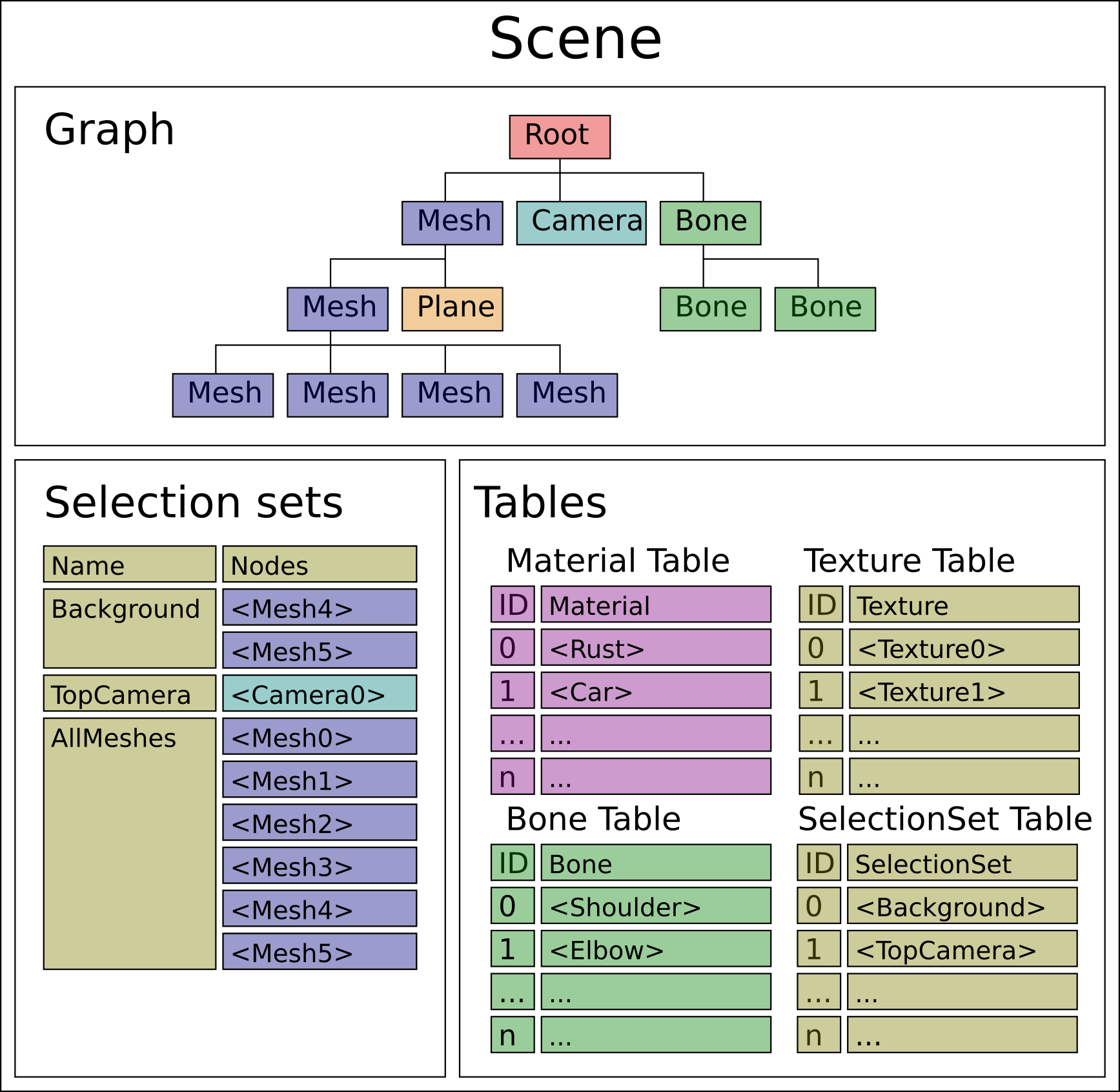场景数据
Simplygon python API提供了类spScene来表示一个场景,一个场景通常包含材质、贴图、骨骼以及网格模型。一个场景默认包含一个场景根节点spSceneNode,一张材质表spMaterialTable,一张纹理表spTextureTable,一张骨骼表spSceneBoneTable和一个选择集表spSelectionSetTable。如下图:

场景类spScene
可使用如下方法来创建一个场景类spScene:
def CreateScene(sg : Simplygon.ISimplygon) -> Simplygon.spScene:
sgScene = sg.CreateScene()
场景类spScene提供了通过路径来获取场景中的节点spSceneNode的方法:
def GetNodeFromPath(self, path: str) -> spSceneNode:
pass
场景节点类spSceneNode提供了GetPath方法来获取节点的路径。
场景类spScene还提供了SaveToFile方法将场景保存成二进制文件:
def SaveToFile(self, path: str) -> bool:
pass
同时提供方法LoadFromFile来从之前保存好的二进制文件中加载场景:
def LoadFromFile(self, path: str) -> bool:
pass
场景节点类spSceneNode
Simplygon python API提供基类 spSceneNode来表示场景中的一个节点,可通过如下方法来创建一个场景节点类spSceneNode:
class ISimplygon(object):
def CreateSceneNode(self) -> Simplygon.spSceneNode:
return _Simplygon.ISimplygon_CreateSceneNode(self)
每个场景节点对象都可以通过名称来从场景对象访问,场景节点对象提供用户如下方法来操作其子节点:
class spSceneNode(spObject):
def GetChildCount(self):
pass
def GetChild(self, index):
pass
def FindNamedChild(self, name):
pass
def AddChild(self, child):
pass
def RemoveChild(self, child):
pass
def RemoveChildren(self):
pass
def HasChild(self, child):
pass
场景节点同样提供了GetPath方法来获取该节点在场景中的路径,每个场景节点保存了其相对父节点的相对变换,这个变换矩阵可通过如下方法获取:
class spSceneNode(spObject):
def GetRelativeTransform(self):
pass
场景节点类也提供了方法来获取其在场景中的绝对变换矩阵:
class spSceneNode(spObject):
def EvaluateDefaultGlobalTransformation(self, global_transform):
pass
上图中的RootNode是一个场景节点类对象,当创建场景对象时会自动创建场景根节点对象。任何场景节点对象必须通过放置在根节点对象的下方层次结构中来添加到场景中。
场景模型类spSceneMesh
Simplygon api提供spSceneMesh代表场景中的模型节点,spSceneMesh继承自场景节点类spSceneNode。spSceneMesh可以通过调用Simplygon的api接口
class ISimplygon(object):
def CreateSceneMesh(self) ->Simplygon.spSceneMesh:
pass
创建得到。要为spSceneMesh设置几何数据,则可通过SetGeometry方法来设置。
class spSceneMesh(spSceneNode):
def SetGeometry(self, geometryData : Simplygon.IGeometrydata):
pass
材质表IMaterialTable
Simplygon场景spScene通过维护材质表IMaterialTable来维护场景中的材质,通过下面的方法可以获得该场景中的材质表:
class spScene:
def GetMaterialTable(self) -> Simplygon.IMaterialTable:
pass
任何为场景创建的材质都必须添加到材质表中,通过使用
class spMaterialTable:
def AddMaterial(self, material : Simplygon.IMaterial) -> int:
pass
上述AddMaterial方法来将材质添加到材质表中,该函数会返回一个唯一的材质id,它被用于给几何数据IGeometryData设置材质,注意:Simplygon场景中的模型的每个三角形面片都需要指定一个对应的材质id。
贴图表ITextureTable
Simplygon场景spScene通过维护贴图表ITextureTable来维护场景中的纹理贴图,它被用户添加或缓存材质着色器网络需要用到的纹理贴图。可通过场景spScene的GetTextureTable方法来获取场景中的纹理表:
class spScene:
def GetTextureTable(self) -> Simplygon.ITextureTable:
pass
要往纹理表中添加贴图,可以通过贴图表ITextureTable的AddTexture方法:
class spTextureTable:
def AddTexture(self, texture :Simplygon.ITexture):
pass




【推荐】国内首个AI IDE,深度理解中文开发场景,立即下载体验Trae
【推荐】编程新体验,更懂你的AI,立即体验豆包MarsCode编程助手
【推荐】抖音旗下AI助手豆包,你的智能百科全书,全免费不限次数
【推荐】轻量又高性能的 SSH 工具 IShell:AI 加持,快人一步
· Ollama——大语言模型本地部署的极速利器
· 使用C#创建一个MCP客户端
· 分享一个免费、快速、无限量使用的满血 DeepSeek R1 模型,支持深度思考和联网搜索!
· Windows编程----内核对象竟然如此简单?
· ollama系列1:轻松3步本地部署deepseek,普通电脑可用